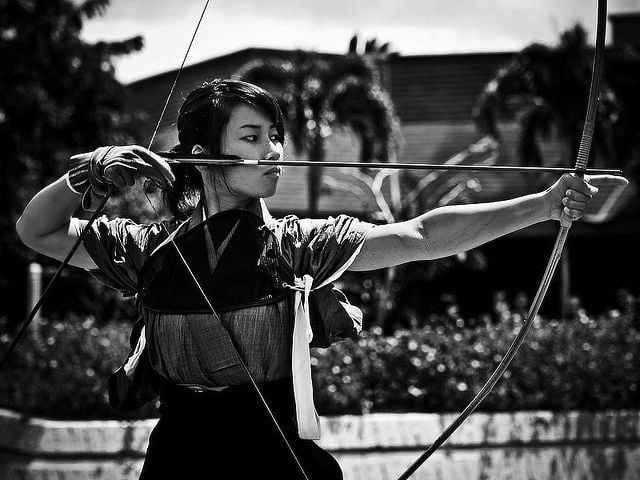
The type of bow we will talk about in this article is the traditional bamboo one. Today there are yumi models made of synthetic fibres, glass fiber or carbon, which allow you to limit production costs, production times and keep the selling price low, making these bows accessible to all. Precisely for these characteristics, fiber bows are most used by beginners and students, who need durable, economical and low-maintenance equipment. The bamboo bow, on the other hand, requires good experience not only in shooting, but also in knowledge of materials and equipment. Even today, as in the past, although there is a vast production of bamboo yumi, made by skilled yumishi (bow makers), the expert archer prefers to make his own bow, usually purchasing a fujibanashi , i.e. a rough, glued bow but not yet finished, to then shape it giving it the shape and power best suited to its technical level.
The globalization of the market and the growing demand has unfortunately affected the quality of raw materials. The great demand for bows and arrows in world kyudo, and the lack of knowledge of the equipment of most modern practitioners, pushes manufacturers, to satisfy market demands, to also turn to bamboo producers outside of Japan, who can guarantee large quantities of raw material at low costs. This has influenced the quality of the finished product, because the yumishi now use bamboo that is not always first choice and pay less and less attention to the creation of the finished yumi, favoring the aesthetic aspect rather than the solidity and efficiency of the bow. Personally I have repaired yumi that broke not due to misuse, but due to poor construction.
As on the continent, at the beginning of Japan’s history the bow was made of a single piece of wood, usually mulberry, and had the classic D shape that we all know. But almost immediately, what would become one of the most obvious characteristics of the Japanese bow, its asymmetry, with the lower limb noticeably shorter than the upper limb, was immediately adopted. It is not known exactly why in Japan they began to use the bow by holding it lower than its geometric center. There are hypotheses ranging from the use of the bow on horseback, to the use of shooting on the knees and others, but the fact is that this way of using the bow became one of the main characteristics of the archers of the islands. Very ancient Chinese documents already refer to island warriors using very long bows, holding them so that the lower limb is considerably shorter than the upper limb. Over time it was understood that using such long bows (the Japanese bow is the longest bow ever, there are examples that exceed 250 cm in length) holding them so low, gave notable advantages in shooting.
Another feature of the Japanese bow is that the arrow is positioned on the right and not on the left, as in Western bows. By doing so, it is possible to open the bow much more, reaching with the right hand up to the shoulder, allowing you to significantly increase the power of the bow and shoot heavier arrows, with greater penetration power.

With the first bows made from a single piece of wood, the yumishi first learned to apply a sheet of bamboo on the external face of the bow, the one that extends and then, a few centuries later, they began to apply a sheet of bamboo also on the face internal, the one that goes into compression. This arch model, made in three parts, internally made of hard wood and externally made of two sheets of flexible bamboo, remained as the basic model of yumi construction for a long time until the Edo period (1603-1868). Over the centuries, with the improvement of technological knowledge and materials, such as animal glues (the glue obtained from deer skin is considered the best animal glue for making yumi) the yumishi also began to make variations of this basic bow model to improve performance and durability. The internal wooden part was replaced by two strips of bamboo or a mix of wood and bamboo, while the bamboo sheet that worked in compression began to be chemically tanned to increase its resistance.

The shape of the bow was also improved, inspired by triple-curved continental models, such as Chinese and Mongolian bows and, during the centuries of war, the Yumishi also refined the lacquering techniques, which allowed the Bushi (warriors) to use the bows in any season, without fear of damaging them. In fact, the unlacquered arches were used at the time from September to May, then, with the arrival of the rainy season and the summer heat, these were left to rest, for fear that using them, the heat could cause the glue to give way. animal. Lacquering allowed the use of the bow in any season and weather. A good lacquer could make the bow gain up to 1 kg of power.

The real turning point came in the Edo period. The pacification of the country by the Tokugawa shogunate allowed the resumption of the improvement study of the bow and the great popularity of the archery competition which was held annually at the Sanjusangen-do temple gave a notable impetus to the development of the equipment. The soft war glove, used for centuries by archers, was replaced with a stiff-thumbed glove with a notch to attach the string to facilitate pulling. This glove is still used today. The construction of the bow and its shape were further improved, thus creating the yumi model that is used today, composed of a series of 3 to 5 internal bamboo strips (higo) flanked by two hardwood strips, usually mulberry. The treatment of the internal sheet in compression was also improved and towards the end of the Edo period this sheet also began to be heat tempered, making it even more robust. Today even the internal bamboo strips are tempered, to further improve the reactivity of the bow. Techniques were developed that allowed shooting for several consecutive hours. Much of the equipment used in modern kyudo was developed in the Edo period, precisely to meet the needs of the archers who participated in this event, which monopolized the world of Japanese archery for 260 years, also triggering criticism from many samurai, who did not look favorably on this event, because it distracted young people from training in traditional combat shooting.
In past centuries there were real companies that produced bows. Many fiefdoms ordered bows for their soldiers from these companies, which ensured that their yumishi made the ordered quantity. Each company had a series of yumishi under contract who made bows of different qualities and therefore different prices. Each yumishi was paid upon delivery of a kori , a package made up of 48 bows, which were carefully checked by the production manager before being shipped to the customer. The builders under contract could neither sign nor freely sell their works. When they made some single piece, it was the company that verified and certified the quality and took care of selling it to the interested customer. Only after the verification and approval of the company could the builder, if authorized, sign the work and the buyer would never have allowed himself to verify the invoice of the arch before purchasing, because the company’s guarantee was enough to certify its excellent quality.
The most obvious feature of this particular bow is its asymmetry, with the handle placed very close to one of the two points of the bow which remain immobile during the draw and which do not develop any vibration when released. The handle placed close to the lower point allows better control of the bow during the release, precisely because the vibrations due to the return of the limbs are much lower than bows held centrally.
Another feature is the offset of the string that passes along the right edge of the bow when it is armed. In the Western bow this misalignment is considered a defect, while in Japanese archery it is an advantage, because it allows the arrow to be launched with a smaller exit angle. Furthermore, the Japanese bow, precisely because of the way it is constructed, tends to rotate to the left after the arrow is released and, in a similar movement, the offset of the string is an advantage.
The fact of being asymmetrical allows the archer to shoot further without having to make an excessive parabola, as the lower limb tends to return to its rest position before the upper limb, thus giving the arrow an upward push. Over time, the Japanese learned to exploit the misalignment of the string, the natural tendency to rotate and the position of the arrow on the right, which allows for greater opening, developing a technique which, through a series of twists applied at the moment of release, gives the arrow greater speed and penetration.
The lacquering of these bows was not ornamental, but had the precise purpose of strengthening and protecting the bow from high summer temperatures and humidity. The further ligatures then added to the lacquering had no particular meaning, other than that of further strengthening the bow. Each clan had its own bindings, but traditionally there was a bow with 32 bindings on the upper limb and 28 on the lower limb. They represented the constellations and particular species of birds, symbolizing the union between heaven and earth. This particular bow, very expensive and of particular quality, was also the symbolic bow of the commanding generals, because it was usually used by them. These lacquered bows were cared for to such an extent that some of them could still be used today. I myself armed a 17th century lacquered war bow and it was still functional!
The construction method of bamboo bows has been around for centuries. Today, like 200 years ago, once the package of sheets has been tied, bamboo wedges are used to fix the shape, waiting for the glue to block everything.

The only difference with the bows of the past is that much more resistant synthetic glues are now used, which guarantee the seal even during the summer heat and in conditions of high humidity. Thanks to these synthetic glues it is no longer necessary to wait months to finish a bow and put it on sale. Now in two or three days the bow is ready. Despite this however, many bows break before they are finished. Bamboo, being a natural material, is unpredictable and between 15 and 20% of bows break or deform before they are even finished. There are modern variations of bamboo bows with carbon fiber inserts. These synthetic inserts help stabilize shape and strength, preventing the bamboo from sagging or warping.
Japan has made the bow a true philosophy of life. The study of materials and refined shooting techniques that have come down to us allow the continuation of the evolution of this extraordinary weapon.



